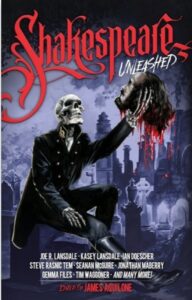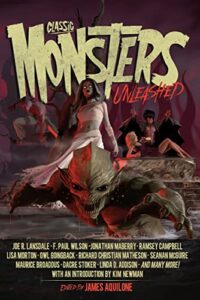Shakespeare Unleashed (Unleashed, #2) edited by James Aquilone
Monstrous Books, 2023
ISBN: 9781946346193
Available: Hardcover, paperback, Kindle
Buy: Bookshop.org | Amazon.com
This is the second book in the Unleashed series, the first being Classic Monsters Unleashed, previokusly reviewed for this website. Like its predecessor, the stories are re-imaginings, continuations, or inspired by the Bard’s work. How does it fare? Pretty well, the book starts slow but gets better throughout, with the real bangers finishing out the book with a flourish. If you haven’t read Shakespeare since being force-fed it in high school, it really helps to at least read the Wikipedia entries for his most famous works before reading the book. Otherwise, a sizable portion of the stories might seem confusing.
The stories pull from a variety of Shakespeare’s work, with none of them used as a subject more than three times. The usual suspects, like Macbeth, Romeo and Juliet, and Hamlet are represented, as well as lesser-known ones like A Midsummer Night’s Dream, The Merchant of Venice, and A Winter’s Tale. Some stories add a prequel or epilogue, or a separate story involving one of the characters. The best ones tend to be the ‘inspired by’ variety, where the basic concept is used in a different setting.
The first quarter of the book may be the weakest, and the hardest to follow, with the story ‘All Hallowed Tides Break Upon These Shores,’ a coda to The Tempest, being a bloody exception. The story quality becomes better and more consistent the rest of the way. Lavinia from Titus Andronicus features in a well-written tale of female revenge, “The Body, The Blood, The Woods, The Stage”, and the lecherous Sir John Falstaff gets a darkly comic dose of payback in “The Hungry Wives of Windsor”.The last quarter of the book is full of excitement and good writing. Standouts are the Macbethian “Case of the Bitter Witch”, the Romeo-esque “Timeless Tragedy,”, and the King Lear inspired “Fortune”: all are outstanding. They take the basic Shakespeare premise and run off in an entirely new direction, with excellent results. It’s worth noting that with only an exception or two, the authors did NOT try to emulate the Bard’s writing style, but wisely stuck with their own styles. The stories do get slick with blood at times, which is fitting, since Shakespeare’s work could be violent at times. He just didn’t write graphically, which is something modern authors can certainly do!
Bottom line? The book is a mixed bag, but there are enough good stories to justify the purchase. Just re-acquaint yourself with Sir William ahead of time before getting the book, then watch the curtain rise on some truly twisted tales.
Reviewed by Murray Samuelson






Follow Us!